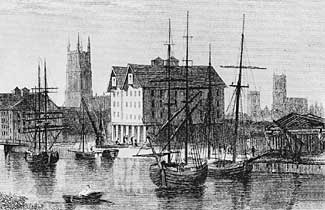 The
Partners The
Partners
Samuel Baker and
Thomas Phillpotts were the leading figures behind the development
of Bakers Quay (pictured right) to the south of Llanthony Bridge.
Both men had made money through owning property in Jamaica and through
bringing the produce of the West Indies to London, and when slavery
was formally abolished in 1834, they were awarded £4283 compensation
for 240 slaves.
Thomas Phillpotts
had been born in Gloucester, and he evidently realised that the
inland position of the recently opened ship canal offered great
advantages to merchants wishing to supply markets in the Midlands.
While continuing with their business in London, the two partners
started importing sugar and other produce from the West Indies direct
to Gloucester, the first consignment being delivered by their own
barque Isabella in September 1833.
Bakers Quay
As well
as trading as merchants, Samuel Baker and Thomas Phillpotts used
their accumulated wealth to invest in property. In particular, they
bought the land known as High Orchard to the south of Llanthony
Bridge with a view to commercial development. At that time, there
was a desperate need for more quay-space at Gloucester, but the
Canal Company could not provide it as they were deeply in debt.
Seeing an opportunity, Baker, Phillpotts and other partners agreed
to widen the canal in front of their land and build a new quay wall
that could be used by all, and they laid out the land behind with
roads and offered plots for sale. Baker also financed the building
of one of a pair of semi-detached warehouses which had their upper
floors supported on pillars over the quay.
The
land behind the northern end of the quay was soon taken up by timber
merchants, some of whom moved from around the Main Basin allowing
more warehouses to be built there. Towards the southern end of Bakers
Quay, a large yard was purchased by the Birmingham & Gloucester
Railway Company, later the Midland Railway Company, which provided
an important means of carrying imports to customers in the Midlands.
To the south of the railway, Thomas Phillpotts was instrumental
in establishing the chemical manufacturing plant of the Anti Dry
Rot Company, a national organisation exploiting the properties of
corrosive sublimate (mercuric chloride) as a wood preservative.
Behind the timber yards, other plots provided sites for a variety
of industries, including a saw mill, a slate works and two iron
foundries. (More about High
Orchard)
The Benefit to Gloucester
The
partners' developments came at just the right time to accommodate
a rapid growth in traffic to Gloucester and to provide space for
industries that continued to flourish throughout the Victorian era.
Gloucester owes much to Samuel Baker and Thomas Phillpotts, but
it is fitting to remember that they in turn owed much to the wealth
generated by the use of slaves. It was appropriate, therefore, that
it was Bakers Quay that was used for shooting scenes for the film
Amazing Grace about the struggle to end slavery.
Sources: TNA RAIL 829 minute books; PP Slave Compensation 1837-38;
GJ ship arrivals; Glos Arch D3117/2536-40; Rate books. |